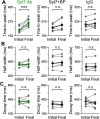Synaptotagmins 1 and 7 Play Complementary Roles in Somatodendritic Dopamine Release
- PMID: 35361702
- PMCID: PMC9097777
- DOI: 10.1523/JNEUROSCI.2416-21.2022
Synaptotagmins 1 and 7 Play Complementary Roles in Somatodendritic Dopamine Release
Abstract
The molecular mechanisms underlying somatodendritic dopamine (DA) release remain unresolved, despite the passing of decades since its discovery. Our previous work showed robust release of somatodendritic DA in submillimolar extracellular Ca2+ concentration ([Ca2+]o). Here we tested the hypothesis that the high-affinity Ca2+ sensor synaptotagmin 7 (Syt7), is a key determinant of somatodendritic DA release and its Ca2+ dependence. Somatodendritic DA release from SNc DA neurons was assessed using whole-cell recording in midbrain slices from male and female mice to monitor evoked DA-dependent D2 receptor-mediated inhibitory currents (D2ICs). Single-cell application of an antibody to Syt7 (Syt7 Ab) decreased pulse train-evoked D2ICs, revealing a functional role for Syt7. The assessment of the Ca2+ dependence of pulse train-evoked D2ICs confirmed robust DA release in submillimolar [Ca2+]o in wild-type (WT) neurons, but loss of this sensitivity with intracellular Syt7 Ab or in Syt7 knock-out (KO) mice. In millimolar [Ca2+]o, pulse train-evoked D2ICs in Syt7 KOs showed a greater reduction in decreased [Ca2+]o than seen in WT mice; the effect on single pulse-evoked DA release, however, did not differ between genotypes. Single-cell application of a Syt1 Ab had no effect on train-evoked D2ICs in WT SNc DA neurons, but did cause a decrease in D2IC amplitude in Syt7 KOs, indicating a functional substitution of Syt1 for Syt7. In addition, Syt1 Ab decreased single pulse-evoked D2ICs in WT cells, indicating the involvement of Syt1 in tonic DA release. Thus, Syt7 and Syt1 play complementary roles in somatodendritic DA release from SNc DA neurons.SIGNIFICANCE STATEMENT The respective Ca2+ dependence of somatodendritic and axonal dopamine (DA) release differs, resulting in the persistence of somatodendritic DA release in submillimolar Ca2+ concentrations too low to support axonal release. We demonstrate that synaptotagmin7 (Syt7), a high-affinity Ca2+ sensor, underlies phasic somatodendritic DA release and its Ca2+ sensitivity in the substantia nigra pars compacta. In contrast, we found that synaptotagmin 1 (Syt1), the Ca2+ sensor underlying axonal DA release, plays a role in tonic, but not phasic, somatodendritic DA release in wild-type mice. However, Syt1 can facilitate phasic DA release after Syt7 deletion. Thus, we show that both Syt1 and Syt7 act as Ca2+ sensors subserving different aspects of somatodendritic DA release processes.
Keywords: D2 dopamine receptors; GIRK channels; autoreceptors; exocytosis; substantia nigra; synaptotagmin 1.
Copyright © 2022 the authors.
Figures







Similar articles
-
Synaptotagmin-7 Counteracts Short-Term Depression during Phasic Dopamine Release.eNeuro. 2024 Mar 12;11(3):ENEURO.0501-23.2024. doi: 10.1523/ENEURO.0501-23.2024. Print 2024 Mar. eNeuro. 2024. PMID: 38365841 Free PMC article.
-
Activity-dependent somatodendritic dopamine release in the substantia nigra autoinhibits the releasing neuron.Cell Rep. 2021 Apr 6;35(1):108951. doi: 10.1016/j.celrep.2021.108951. Cell Rep. 2021. PMID: 33826884 Free PMC article.
-
Novel Ca2+ dependence and time course of somatodendritic dopamine release: substantia nigra versus striatum.J Neurosci. 2001 Oct 1;21(19):7841-7. doi: 10.1523/JNEUROSCI.21-19-07841.2001. J Neurosci. 2001. PMID: 11567075 Free PMC article.
-
Somatodendritic dopamine release: recent mechanistic insights.Philos Trans R Soc Lond B Biol Sci. 2015 Jul 5;370(1672):20140185. doi: 10.1098/rstb.2014.0185. Philos Trans R Soc Lond B Biol Sci. 2015. PMID: 26009764 Free PMC article. Review.
-
Functional interactions between somatodendritic dopamine release, glutamate receptors and brain-derived neurotrophic factor expression in mesencephalic structures of the brain.Brain Res Brain Res Rev. 2004 Dec;47(1-3):126-44. doi: 10.1016/j.brainresrev.2004.05.002. Brain Res Brain Res Rev. 2004. PMID: 15572168 Review.
Cited by
-
Synaptotagmin-7 Counteracts Short-Term Depression during Phasic Dopamine Release.eNeuro. 2024 Mar 12;11(3):ENEURO.0501-23.2024. doi: 10.1523/ENEURO.0501-23.2024. Print 2024 Mar. eNeuro. 2024. PMID: 38365841 Free PMC article.
-
Synaptotagmin-1-dependent phasic axonal dopamine release is dispensable for basic motor behaviors in mice.Nat Commun. 2023 Jul 11;14(1):4120. doi: 10.1038/s41467-023-39805-7. Nat Commun. 2023. PMID: 37433762 Free PMC article.
-
Mechanisms of Synaptic Vesicle Exo- and Endocytosis.Biomedicines. 2022 Jul 4;10(7):1593. doi: 10.3390/biomedicines10071593. Biomedicines. 2022. PMID: 35884898 Free PMC article. Review.
-
Synaptotagmin-1 is a Ca2+ sensor for somatodendritic dopamine release.Cell Rep. 2023 Jan 31;42(1):111915. doi: 10.1016/j.celrep.2022.111915. Epub 2022 Dec 30. Cell Rep. 2023. PMID: 36640316 Free PMC article.
-
Kv4.2 Regulates Basal Synaptic Strength by Inhibiting R-Type Calcium Channels in the Hippocampus.J Neurosci. 2025 Mar 19;45(12):e0444242025. doi: 10.1523/JNEUROSCI.0444-24.2025. J Neurosci. 2025. PMID: 39933929
References
-
- Baker K, Gordon SL, Grozeva D, van Kogelenberg M, Roberts NY, Pike M, Blair E, Hurles ME, Chong WK, Baldeweg T, Kurian MA, Boyd SG, Cousin MA, Raymond FL (2015) Identification of a human synaptotagmin-1 mutation that perturbs synaptic vesicle cycling. J Clin Invest 125:1670–1678. 10.1172/JCI79765 - DOI - PMC - PubMed
MeSH terms
Substances
Grants and funding
LinkOut - more resources
Full Text Sources
Molecular Biology Databases
Research Materials
Miscellaneous
